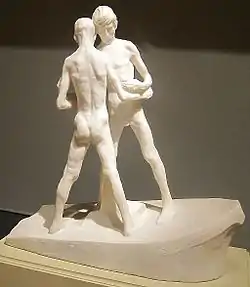George Minne
George (Georges) Minne (born Georgius Joannes Leonardus Minne; 30 August 1866 – 18 February 1941) was a Belgian artist and sculptor famous for his idealized depictions of man's inner spiritual conflicts, including the "Kneeling Youth" sculpture series. A contemporary of Gustav Klimt and Egon Schiele, Minne's work shows many similarities in both form and subject matter to the Viennese Secessionists, the fathers of Art Nouveau.

Life
He was born in Ghent, Belgium as the son of an architect (Fredericus Augustus Minne). In 1879, Minne studied painting at the Royal Academy of Fine Arts in Ghent, then in the Académie Royale des Beaux-Arts in Brussels from 1885 through 1889. In 1891 he was elected a member of the arts group Les XX.[1] He had made his first visit to Paris in 1886 where he met the writers Maurice Maeterlinck and Gregore Le Roy, who introduced him to the French Symbolists. Minne returned to Paris in 1890 and asked Auguste Rodin for permission to work in his studio, Rodin told him, "I have nothing to teach you."
In 1892, Minne married Josephine Destanberg, the daughter of a Ghent poet. He then spent most of his time drawing and sculpting. He established his own bronze foundry in 1910–14, in Ghent, which was managed by his son. During World War I he fled to Wales, but returned after the war, and taught drawing.[1]
Works

His most famous works are the "Kneeling Youth" series of sculptures, including "The Fountain of Kneeling Youths", a bronze-cast fountain in his home town of Ghent (the Marble originals are at the Folkwang Museum in Essen, Germany), as well as various smaller sculptures in private and museum holdings, such as the pair of "Kneeling Youths" at the Neue Galerie New York and the plaster of "Kneeling Youth" (1898) acquired in 2011 by the National Gallery of Victoria, Melbourne.
The Neue Galerie's "Kneeling Youth" sculptures were previously owned by Adele Bloch-Bauer and her husband Ferdinand Bloch-Bauer, a wealthy industrialist. The sculptures were confiscated by the Nazis, and only through extensive restitution efforts were they returned to Bloch-Bauer's niece Maria Altmann, and eventually acquired by the museum.[2]
For the Basilica of Koekelberg Minne made the sculpture of the Sacred Heart for the altar in the apse. He also made the bronze calvarie at the outside of the basilica.
Honours
- 1931 : Created baron by Royal Order of 25 April.
- 1934 : Grand officer in the Order of the Crown.[3]
- Member of the Royal Academy of Science, Letters and Fine Arts of Belgium
References
- Price, Renée. New Worlds: German and Austrian Art 1890-1940, New York: Neue Galerie, 2001.
- Gaugusch, Georg (2009). Portrait of Adele Bloch-Bauer. New York: Neue Galerie.
- Royal Order of 7.4.1934
Further reading
- Kultermann, Udo. "The Fountain of Youth: The Folkwang Fountain by George Minne," Konsthistorik Tidskrift 46:2 (1977):144-152.
- van Puyvelde, Leo. George Minne, Brussels: Editions des Cahiers de Belgique, 1930.